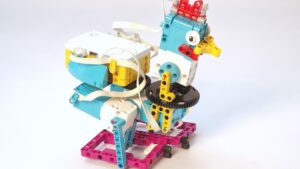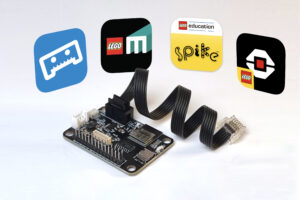Building a snake-like robot that navigates autonomously while dodging obstacles is a fascinating robotics challenge. Below, I’ll break down how this Pybricks code (for LEGO MINDSTORMS Robot Inventor) brings a serpentine bot to life. The robot uses sine-wave motion for propulsion and ultrasonic sensing for obstacle detection. I originally programmed the snake in Robot Inventor Python, but Pybricks makes the code so much easier to read, so I ported and rebuilt the code.
How the Snake Robot Works
- Undulating Motion
Motors in each segment follow a sine-wave pattern, creating a traveling wave that propels the robot forward. The wave propagates from tail to head when moving straight. - Direction Control
Pressing the hub’s left/right buttons adjusts the phase offset between segments, steering the robot by shifting the wave direction. - Obstacle Avoidance
An ultrasonic sensor on the “head” detects obstacles within 15 cm. When triggered, the robot:- Temporarily bends its entire body sideways (
TURN = 30°). - Resumes straight motion after one undulation cycle (
PERIOD = 3500 ms). - Head LEDs change color to indicate avoidance mode.
- Temporarily bends its entire body sideways (
Annotated Code
Let’s start with the code first. I have added comments to make it easy to follow. Then, read on to find more explanation of the movement principles and wave terminology like ‘phase’, ‘offset’, and ‘period’.
from pybricks.pupdevices import Motor, UltrasonicSensor
from pybricks.hubs import InventorHub
from pybricks.parameters import Port, Button
from umath import sin, pi # Import sine and pi for wave math
from pybricks.tools import StopWatch, wait
# --- Constants ---
PERIOD = 3500 # Wave cycle duration (ms)
TIME_FACTOR = 2*pi / PERIOD # Convert time to radians
MAX_ANGLE = 40 # Max motor swing (degrees)
OFFSET_INCREMENT = -pi/15 # Phase shift per button press (radians)
TURN = 30 # Avoidance turn angle (degrees)
# --- Hardware Setup ---
m1 = Motor(Port.C) # Tail motor
m2 = Motor(Port.D) # Mid-motor 1
m3 = Motor(Port.E) # Mid-motor 2
m4 = Motor(Port.F) # Head motor
head = UltrasonicSensor(Port.A) # Obstacle detector
hub = InventorHub() # Central hub
motors = [m1, m2, m3, m4] # All motors in order
sw = StopWatch() # Tracks wave timing
turn_sw = StopWatch() # Times avoidance maneuvers
# --- Initial State ---
offset = 0 # Current phase shift
offset_number = 0 # Button-press counter
turn = 0 # Avoidance turn (0 when straight)
head.lights.on([0,0,100,100]) # Blue headlights (idle)
# --- Main Loop ---
while True:
# 1. Update Motor Positions (Snake Wave)
i = 0
for m in motors:
# Calculate motor angle:
# Sine wave + segment offset + avoidance turn
angle = MAX_ANGLE * sin(sw.time() * TIME_FACTOR + i * offset) + turn
m.track_target(angle) # Move motor to target
i += 1
# 2. Obstacle Avoidance Logic
if head.distance() < 150 and abs(offset_number) > 1:
turn_sw.reset() # Start turn timer
turn = TURN # Bend body sideways
head.lights.on([100,100,100,100]) # White headlights (avoiding)
# Return straight after one wave cycle
if turn == TURN and turn_sw.time() > PERIOD:
turn = 0 # Reset turn
head.lights.on([0,0,50,50]) # Dim blue (resuming)
# 3. Steering via Hub Buttons
btns = hub.buttons.pressed()
if btns:
if Button.LEFT in btns:
offset_number -= 1 # Shift wave left
elif Button.RIGHT in btns:
offset_number += 1 # Shift wave right
offset = OFFSET_INCREMENT * offset_number # Apply phase shift
wait(300) # Debounce delay
hub.display.number(offset_number) # Show steering intensityUnderstanding Wave Motion in Snake Robots: Phase, Offset, and Period
In the context of the snake robot’s movement, these terms describe how the sine wave controlling the motors creates traveling waves along the body. Here’s a breakdown.
1. Period (PERIOD = 3500 ms)
- What it is: The time for one complete wave cycle.
- Snake analogy: How long it takes for one “S-shaped” undulation to travel from head to tail.
- In practice:
PERIOD = 3500 msmeans the wave repeats every 3.5 seconds.- Controls the robot’s speed:
python TIME_FACTOR = 2*pi / PERIOD # Converts time to wave position
2. Phase
- What it is: The current position in the wave cycle (0 to 2π radians).
- Snake analogy: Where in the “S-curve” a body segment is at any moment.
- In the code:
angle = MAX_ANGLE * sin(sw.time() * TIME_FACTOR + ...)sw.time() * TIME_FACTORcalculates the phase based on elapsed time.- At time
t=0, phase=0→ middle of the wave (motor angle=0°). - At phase=
π/2→ peak of the wave (motor angle=+40°).
3. Offset (offset = -π/15 * offset_number)
- What it is: A deliberate phase shift between adjacent motors.
- Snake analogy: How much each segment lags behind the previous one.
- In the code:
angle = ... + i * offset # i = motor index (0,1,2,3)- For motor
i=0(tail): phase =base_phase + 0*offset - For motor
i=1: phase =base_phase + 1*offset - For motor
i=2: phase =base_phase + 2*offset
Why it matters
- offset = 0 → All motors move together (no wave, robot doesn’t advance).
- offset = -π/15 (≈ -12°) → Each motor lags 12° behind the previous one, creating a traveling wave from tail to head.
Visualizing the Wave
| Time | Tail (i=0) | Mid 1 (i=1) | Mid 2 (i=2) | Head (i=3) |
|---|---|---|---|---|
t | sin(θ) | sin(θ – 12°) | sin(θ – 24°) | sin(θ – 36°) |
t+1 | sin(θ+1°) | sin(θ – 11°) | sin(θ – 23°) | sin(θ – 35°) |
This staggered motion (offset) creates a propagating wave that pushes against the ground, moving the robot forward.
Steering via Offset
- Left button press:
offset_number -= 1 → offset = -π/15 * (negative number)- Negative offset → Wave travels left-to-right → Robot turns right.
- Right button press:
offset_number += 1 → offset = -π/15 * (positive number)- Positive offset → Wave travels right-to-left → Robot turns left.
Key Insight
The combination of period (wave speed), phase (instantaneous motor position), and offset (inter-motor delay) creates biomimetic serpentine motion. Adjusting these values lets you tune the robot’s speed, gait, and turning radius!
In short: Key Snake Movement Mechanisms Explained
- Sine Wave Propulsion:
Each motor’s angle followsMAX_ANGLE * sin(time + phase_offset). Theoffsetcreates a delay between adjacent motors, forming a traveling wave.
Example:offset = -π/15shifts each motor 12° behind the previous one. - Steering:
Pressing LEFT/RIGHT incrementsoffset_number, increasing the phase shift. This skews the wave direction, turning the robot: - Positive
offset_number→ Right turn - Negative
offset_number→ Left turn - Obstacle Response:
When the ultrasonic sensor detects an obstacle (<150 mm), the robot overrides all motors with a fixedTURNangle. After one wave cycle (PERIOD), it reverts to sine motion.
Tips for Customization
- Adjust Responsiveness:
ModifyOFFSET_INCREMENTto change steering sensitivity (larger values = sharper turns). - Tune Motion:
IncreaseMAX_ANGLEfor wider slithers or reducePERIODfor faster movement. - Enhance Avoidance:
ChangeTURNor add backward motion by setting negative angles during avoidance.
This implementation elegantly combines trigonometry for biomimetic motion with reactive obstacle avoidance—all in under 50 lines! The result is a mesmerizing robotic snake that navigates spaces with lifelike grace.







